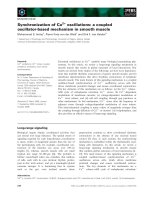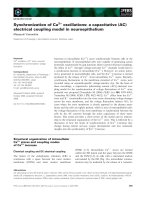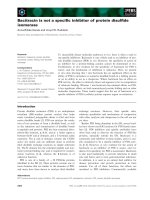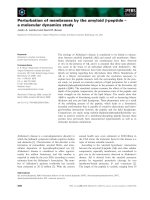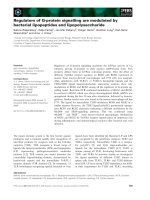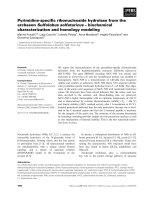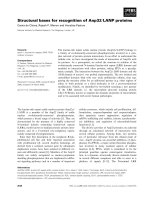Tài liệu Báo cáo khoa học: "Machine Learning for Coreference Resolution: From Local Classification to Global Ranking" ppt
Bạn đang xem bản rút gọn của tài liệu. Xem và tải ngay bản đầy đủ của tài liệu tại đây (97.58 KB, 8 trang )
Proceedings of the 43rd Annual Meeting of the ACL, pages 157–164,
Ann Arbor, June 2005.
c
2005 Association for Computational Linguistics
Machine Learning for Coreference Resolution:
From Local Classification to Global Ranking
Vincent Ng
Human Language Technology Research Institute
University of Texas at Dallas
Richardson, TX 75083-0688
Abstract
In this paper, we view coreference reso-
lution as a problem of ranking candidate
partitions generated by different coref-
erence systems. We propose a set of
partition-based features to learn a rank-
ing model for distinguishing good and bad
partitions. Our approach compares fa-
vorably to two state-of-the-art coreference
systems when evaluated on three standard
coreference data sets.
1 Introduction
Recent research in coreference resolution — the
problem of determining which noun phrases (NPs)
in a text or dialogue refer to which real-world
entity — has exhibited a shift from knowledge-
based approaches to data-driven approaches, yield-
ing learning-based coreference systems that rival
their hand-crafted counterparts in performance (e.g.,
Soon et al. (2001), Ng and Cardie (2002b), Strube et
al. (2002), Yang et al. (2003), Luo et al. (2004)). The
central idea behind the majority of these learning-
based approaches is to recast coreference resolution
as a binary classification task. Specifically, a clas-
sifier is first trained to determine whether two NPs
in a document are co-referring or not. A separate
clustering mechanism then coordinates the possibly
contradictory pairwise coreference classification de-
cisions and constructs a partition on the given set of
NPs, with one cluster for each set of coreferent NPs.
Though reasonably successful, this “standard” ap-
proach is not as robust as one may think. First, de-
sign decisions such as the choice of the learning al-
gorithm and the clustering procedure are apparently
critical to system performance, but are often made
in an ad-hoc and unprincipled manner that may be
suboptimal from an empirical point of view.
Second, this approach makes no attempt to search
through the space of possible partitions when given
a set of NPs to be clustered, employing instead a
greedy clustering procedure to construct a partition
that may be far from optimal.
Another potential weakness of this approach con-
cerns its inability to directly optimize for clustering-
level accuracy: the coreference classifier is trained
and optimized independently of the clustering pro-
cedure to be used, and hence improvements in clas-
sification accuracy do not guarantee corresponding
improvements in clustering-level accuracy.
Our goal in this paper is to improve the robustness
of the standard approach by addressing the above
weaknesses. Specifically, we propose the following
procedure for coreference resolution: given a set of
NPs to be clustered, (1) use
pre-selected learning-
based coreference systems to generate candidate
partitions of the NPs, and then (2) apply an auto-
matically acquired ranking model to rank these can-
didate hypotheses, selecting the best one to be the fi-
nal partition. The key features of this approach are:
Minimal human decision making. In contrast to
the standard approach, our method obviates, to a
large extent, the need to make tough or potentially
suboptimal design decisions.
1
For instance, if we
1
We still need to determine the
coreference systems to be
employed in our framework, however. Fortunately, the choice
of is flexible, and can be as large as we want subject to the
157
cannot decide whether learner is better to use than
learner in a coreference system, we can simply
create two copies of the system with one employing
and the other , and then add both into our pre-
selected set of coreference systems.
Generation of multiple candidate partitions. Al-
though an exhaustive search for the best partition is
not computationally feasible even for a document
with a moderate number of NPs, our approach ex-
plores a larger portion of the search space than the
standard approach via generating multiple hypothe-
ses, making it possible to find a potentially better
partition of the NPs under consideration.
Optimization for clustering-level accuracy via
ranking. As mentioned above, the standard ap-
proach trains and optimizes a coreference classifier
without necessarily optimizing for clustering-level
accuracy. In contrast, we attempt to optimize our
ranking model with respect to the target coreference
scoring function, essentially by training it in such
a way that a higher scored candidate partition (ac-
cording to the scoring function) would be assigned a
higher rank (see Section 3.2 for details).
Perhaps even more importantly, our approach pro-
vides a general framework for coreference resolu-
tion. Instead of committing ourselves to a partic-
ular resolution method as in previous approaches,
our framework makes it possible to leverage the
strengths of different methods by allowing them to
participate in the generation of candidate partitions.
We evaluate our approach on three standard coref-
erence data sets using two different scoring met-
rics. In our experiments, our approach compares fa-
vorably to two state-of-the-art coreference systems
adopting the standard machine learning approach,
outperforming them by as much as 4–7% on the
three data sets for one of the performance metrics.
2 Related Work
As mentioned before, our approach differs from the
standard approach primarily by (1) explicitly learn-
ing a ranker and (2) optimizing for clustering-level
accuracy. In this section we will focus on discussing
related work along these two dimensions.
Ranking candidate partitions. Although we are
not aware of any previous attempt on training a
available computing resources.
ranking model using global features of an NP par-
tition, there is some related work on partition rank-
ing where the score of a partition is computed via
a heuristic function of the probabilities of its NP
pairs being coreferent.
2
For instance, Harabagiu et
al. (2001) introduce a greedy algorithm for finding
the highest-scored partition by performing a beam
search in the space of possible partitions. At each
step of this search process, candidate partitions are
ranked based on their heuristically computed scores.
Optimizing for clustering-level accuracy. Ng
and Cardie (2002a) attempt to optimize their rule-
based coreference classifier for clustering-level ac-
curacy, essentially by finding a subset of the learned
rules that performs the best on held-out data with
respect to the target coreference scoring program.
Strube and M¨uller (2003) propose a similar idea, but
aim instead at finding a subset of the available fea-
tures with which the resulting coreference classifier
yields the best clustering-level accuracy on held-out
data. To our knowledge, our work is the first attempt
to optimize a ranker for clustering-level accuracy.
3 A Ranking Approach to Coreference
Our ranking approach operates by first dividing the
available training texts into two disjoint subsets: a
training subset and a held-out subset. More specifi-
cally, we first train each of our
pre-selected coref-
erence systems on the documents in the training sub-
set, and then use these resolvers to generate can-
didate partitions for each text in the held-out subset
from which a ranking model will be learned. Given
a test text, we use our coreference systems to cre-
ate candidate partitions as in training, and select
the highest-ranked partition according to the ranking
model to be the final partition.
3
The rest of this sec-
tion describes how we select these learning-based
coreference systems and acquire the ranking model.
3.1 Selecting Coreference Systems
A learning-based coreference system can be defined
by four elements: the learning algorithm used to
train the coreference classifier, the method of creat-
ing training instances for the learner, the feature set
2
Examples of such scoring functions include the Dempster-
Shafer rule (see Kehler (1997) and Bean and Riloff (2004)) and
its variants (see Harabagiu et al. (2001) and Luo et al. (2004)).
3
The ranking model breaks ties randomly.
158
used to represent a training or test instance, and the
clustering algorithm used to coordinate the coref-
erence classification decisions. Selecting a corefer-
ence system, then, is a matter of instantiating these
elements with specific values.
Now we need to define the set of allowable values
for each of these elements. In particular, we want to
define them in such a way that the resulting coref-
erence systems can potentially generate good can-
didate partitions. Given that machine learning ap-
proaches to the problem have been promising, our
choices will be guided by previous learning-based
coreference systems, as described below.
Training instance creation methods. A training
instance represents two NPs, NP
and NP , having a
class value of COREFERENT or NOT COREFERENT
depending on whether the NPs co-refer in the asso-
ciated text. We consider three previously-proposed
methods of creating training instances.
In McCarthy and Lehnert’s method, a positive
instance is created for each anaphoric NP paired
with each of its antecedents, and a negative instance
is created by pairing each NP with each of its preced-
ing non-coreferent noun phrases. Hence, the number
of instances created by this method is quadratic in
the number of NPs in the associated text. The large
number of instances can potentially make the train-
ing process inefficient.
In an attempt to reduce the training time, Soon et
al.’s method creates a smaller number of training in-
stances than McCarthy and Lehnert’s. Specifically,
a positive instance is created for each anaphoric NP,
NP
, and its closest antecedent, NP ; and a negative
instance is created for NP paired with each of the
intervening NPs, NP , NP , , NP .
Unlike Soon et al., Ng and Cardie’s methodgen-
erates a positive instance for each anaphoric NP and
its most confident antecedent. For a non-pronominal
NP, the most confident antecedent is assumed to
be its closest non-pronominal antecedent. For pro-
nouns, the most confident antecedent is simply its
closest preceding antecedent. Negative instances are
generated as in Soon et al.’s method.
Feature sets. We employ two feature sets for rep-
resenting an instance, as described below.
Soon et al.’s feature set consists of 12 surface-
level features, each of which is computed based on
one or both NPs involved in the instance. The fea-
tures can be divided into four groups: lexical, gram-
matical, semantic, and positional. Space limitations
preclude a description of these features. Details can
be found in Soon et al. (2001).
Ng and Cardie expand Soon et al.’s feature set
from 12 features to a deeper set of 53 to allow more
complex NP string matching operations as well as
finer-grained syntactic and semantic compatibility
tests. See Ng and Cardie (2002b) for details.
Learning algorithms. We consider three learning
algorithms, namely, the C4.5 decision tree induction
system (Quinlan, 1993), the RIPPER rule learning
algorithm (Cohen, 1995), and maximum entropy
classification (Berger et al., 1996). The classifica-
tion model induced by each of these learners returns
a number between 0 and 1 that indicates the likeli-
hood that the two NPs under consideration are coref-
erent. In this work, NP pairs with class values above
0.5 are considered COREFERENT; otherwise the pair
is considered NOT COREFERENT.
Clustering algorithms. We employ three cluster-
ing algorithms, as described below.
The closest-first clustering algorithm selects as
the antecedent of NP
its closest preceding coreferent
NP. If no such NP exists, then NP is assumed to be
non-anaphoric (i.e., no antecedent is selected).
On the other hand, the best-first clustering al-
gorithm selects as the antecedent of NP the clos-
est NP with the highest coreference likelihood value
from its set of preceding coreferent NPs. If this
set is empty, then no antecedent is selected for NP .
Since the most likely antecedent is chosen for each
NP, best-first clustering may produce partitions with
higher precision than closest-first clustering.
Finally, in aggressive-merge clustering, each NP
is merged with all of its preceding coreferent NPs.
Since more merging occurs in comparison to the pre-
vious two algorithms, aggressive-merge clustering
may yield partitions with higher recall.
Table 1 summarizes the previous work on coref-
erence resolution that employs the learning algo-
rithms, clustering algorithms, feature sets, and in-
stance creation methods discussed above. With three
learners, three training instance creation methods,
two feature sets, and three clustering algorithms, we
can produce 54 coreference systems in total.
159
Decision tree learners Aone and Bennett (1995), McCarthy and Lehnert (1995), Soon et al. (2001),
Learning (C4.5/C5/CART) Strube et al. (2002), Strube and M¨uller (2003), Yang et al. (2003)
algorithm RIPPER Ng and Cardie (2002b)
Maximum entropy Kehler (1997), Morton (2000), Luo et al. (2004)
Instance McCarthy and Lehnert’s McCarthy and Lehnert (1995), Aone and Bennett (1995)
creation Soon et al.’s Soon et al. (2001), Strube et al. (2002), Iida et al. (2003)
method Ng and Cardie’s Ng and Cardie (2002b)
Feature Soon et al.’s Soon et al. (2001)
set Ng and Cardie’s Ng and Cardie (2002b)
Clustering Closest-first Soon et al. (2001), Strube et al. (2002)
algorithm Best-first Aone and Bennett (1995), Ng and Cardie (2002b), Iida et al. (2003)
Aggressive-merge McCarthy and Lehnert (1995)
Table 1: Summary of the previous work on coreference resolution that employs the learning algorithms, the
clustering algorithms, the feature sets, and the training instance creation methods discussed in Section 3.1.
3.2 Learning to Rank Candidate Partitions
We train an SVM-based ranker for ranking candidate
partitions by means of Joachims’ (2002) SVM
package, with all the parameters set to their default
values. To create training data, we first generate 54
candidate partitions for each text in the held-out sub-
set as described above and then convert each parti-
tion into a training instance consisting of a set of
partition-based features and method-based features.
Partition-based features are used to characterize a
candidate partition and can be derived directly from
the partition itself. Following previous work on us-
ing global features of candidate structures to learn
a ranking model (Collins, 2002), the global (i.e.,
partition-based) features we consider here are sim-
ple functions of the local features that capture the
relationship between NP pairs.
Specifically, we define our partition-based fea-
tures in terms of the features in the Ng and Cardie
(N&C) feature set (see Section 3.1) as follows. First,
let us assume that
is the -th nominal feature in
N&C’s feature set and is the -th possible value
of . Next, for each and , we create two partition-
based features, and . is computed over
the set of coreferent NP pairs (with respect to the
candidate partition), denoting the probability of en-
countering in this set when the pairs are
represented as attribute-value vectors using N&C’s
features. On the other hand, is computed over
the set of non-coreferent NP pairs (with respect to
the candidate partition), denoting the probability of
encountering in this set when the pairs are
represented as attribute-value vectors using N&C’s
features. One partition-based feature, for instance,
would denote the probability that two NPs residing
in the same cluster have incompatible gender values.
Intuitively, a good NP partition would have a low
probability value for this feature. So, having these
partition-based features can potentially help us dis-
tinguish good and bad candidate partitions.
Method-based features, on the other hand, are
used to encode the identity of the coreference sys-
tem that generated the candidate partition under con-
sideration. Specifically, we have one method-based
feature representing each pre-selected coreference
system. The feature value is 1 if the corresponding
coreference system generated the candidate partition
and 0 otherwise. These features enable the learner
to learn how to distinguish good and bad partitions
based on the systems that generated them, and are
particularly useful when some coreference systems
perform consistently better than the others.
Now, we need to compute the “class value” for
each training instance, which is a positive integer de-
noting the rank of the corresponding partition among
the 54 candidates generated for the training docu-
ment under consideration. Recall from the intro-
duction that we want to train our ranking model so
that higher scored partitions according to the target
coreference scoring program are ranked higher. To
this end, we compute the rank of each candidate par-
tition as follows. First, we apply the target scoring
program to score each candidate partition against the
correct partition derived from the training text. We
then assign rank
to the -th lowest scored parti-
tion.
4
Effectively, the learning algorithm learns what
a good partition is from the scoring program.
4
Two partitions with the same score will have the same rank.
160
Training Corpus Test Corpus
# Docs # Tokens # Docs # Tokens
BNEWS 216 67470 51 18357
NPAPER 76 71944 17 18174
NWIRE 130 85688 29 20528
Table 2: Statistics for the ACE corpus.
4 Evaluation
4.1 Experimental Setup
For evaluation purposes, we use the ACE (Au-
tomatic Content Extraction) coreference corpus,
which is composed of three data sets created
from three different news sources, namely, broad-
cast news (BNEWS), newspaper (NPAPER), and
newswire (NWIRE).
5
Statistics of these data sets are
shown in Table 2. In our experiments, we use the
training texts to acquire coreference classifiers and
evaluate the resulting systems on the test texts with
respect to two commonly-used coreference scoring
programs: the MUC scorer (Vilain et al., 1995) and
the B-CUBED scorer (Bagga and Baldwin, 1998).
4.2 Results Using the MUC Scorer
Baseline systems. We employ as our baseline sys-
tems two existing coreference resolvers: our dupli-
cation of the Soon et al. (2001) system and the Ng
and Cardie (2002b) system. Both resolvers adopt
the standard machine learning approach and there-
fore can be characterized using the four elements
discussed in Section 3.1. Specifically, Soon et al.’s
system employs a decision tree learner to train a
coreference classifier on instances created by Soon’s
method and represented by Soon’s feature set, coor-
dinating the classification decisions via closest-first
clustering. Ng and Cardie’s system, on the other
hand, employs RIPPER to train a coreference classi-
fier on instances created by N&C’s method and rep-
resented by N&C’s feature set, inducing a partition
on the given NPs via best-first clustering.
The baseline results are shown in rows 1 and 2
of Table 3, where performance is reported in terms
of recall, precision, and F-measure. As we can see,
the N&C system outperforms the Duplicated Soon
system by about 2-6% on the three ACE data sets.
5
See />tests/ace for details on the ACE research program.
Our approach. Recall that our approach uses la-
beled data to train both the coreference classifiers
and the ranking model. To ensure a fair comparison
of our approach with the baselines, we do not rely
on additional labeled data for learning the ranker;
instead, we use half of the training texts for training
classifiers and the other half for ranking purposes.
Results using our approach are shown in row 3 of
Table 3. Our ranking model, when trained to opti-
mize for F-measure using both partition-based fea-
tures and method-based features, consistently pro-
vides substantial gains in F-measure over both base-
lines. In comparison to the stronger baseline (i.e.,
N&C), F-measure increases by 7.4, 7.2, and 4.6 for
the BNEWS, NPAPER, and NWIRE data sets, re-
spectively. Perhaps more encouragingly, gains in F-
measure are accompanied by simultaneous increase
in recall and precision for all three data sets.
Feature contribution. In an attempt to gain addi-
tional insight into the contribution of partition-based
features and method-based features, we train our
ranking model using each type of features in iso-
lation. Results are shown in rows 4 and 5 of Ta-
ble 3. For the NPAPER and NWIRE data sets, we
still see gains in F-measure over both baseline sys-
tems when the model is trained using either type of
features. The gains, however, are smaller than those
observed when the two types of features are applied
in combination. Perhaps surprisingly, the results for
BNEWS do not exhibit the same trend as those for
the other two data sets. Here, the method-based fea-
tures alone are strongly predictive of good candidate
partitions, yielding even slightly better performance
than when both types of features are applied. Over-
all, however, these results seem to suggest that both
partition-based and method-based features are im-
portant to learning a good ranking model.
Random ranking. An interesting question is:
how much does supervised ranking help? If all of
our candidate partitions are of very high quality, then
ranking will not be particularly important because
choosing any of these partitions may yield good re-
sults. To investigate this question, we apply a ran-
dom ranking model, which randomly selects a can-
didate partition for each test text. Row 6 of Table 3
shows the results (averaged over five runs) when the
random ranker is used in place of the supervised
161
BNEWS NPAPER NWIRE
System Variation R P F R P F R P F
1 Duplicated Soon et al. baseline 52.7 47.5 50.0 63.3 56.7 59.8 48.7 40.9 44.5
2 Ng and Cardie baseline 56.5 58.6 57.5 57.1 68.0 62.1 43.1 59.9 50.1
3 Ranking framework 62.2 67.9 64.9 67.4 71.4 69.3 50.1 60.3 54.7
4 Partition-based features only 54.5 55.5 55.0 66.3 63.0 64.7 50.7 51.2 51.0
5 Method-based features only 62.0 68.5 65.1 67.5 61.2 64.2 51.1 49.9 50.5
6 Random ranking model 48.6 54.8 51.5 57.4 63.3 60.2 40.3 44.3 42.2
7 Perfect ranking model 66.0 69.3 67.6 70.4 71.2 70.8 56.6 59.7 58.1
Table 3: Results for the three ACE data sets obtained via the MUC scoring program.
ranker. In comparison to the results in row 3, we
see that the supervised ranker surpasses its random
counterpart by about 9-13% in F-measure, implying
that ranking plays an important role in our approach.
Perfect ranking. It would be informative to see
whether our ranking model is performing at its up-
per limit, because further performance improvement
beyond this point would require enlarging our set of
candidate partitions. So, we apply a perfect ranking
model, which uses an oracle to choose the best can-
didate partition for each test text. Results in row 7 of
Table 3 indicate that our ranking model performs at
about 1-3% below the perfect ranker, suggesting that
we can further improve coreference performance by
improving the ranking model.
4.3 Results Using the B-CUBED Scorer
Baseline systems. In contrast to the MUC results,
the B-CUBED results for the two baseline systems
are mixed (see rows 1 and 2 of Table 4). Specifically,
while there is no clear winner for the NWIRE data
set, N&C performs better on BNEWS but worse on
NPAPER than the Duplicated Soon system.
Our approach. From row 3 of Table 4, we see that
our approach achieves small but consistent improve-
ments in F-measure over both baseline systems. In
comparison to the better baseline, F-measure in-
creases by 0.1, 1.1, and 2.0 for the BNEWS, NPA-
PER, and NWIRE data sets, respectively.
Feature contribution. Unlike the MUC results,
using more features to train the ranking model does
not always yield better performance with respect to
the B-CUBED scorer (see rows 3-5 of Table 4). In
particular, the best result for BNEWS is achieved
using only method-based features, whereas the best
result for NPAPER is obtained using only partition-
based features. Nevertheless, since neither type of
features offers consistently better performance than
the other, it still seems desirable to apply the two
types of features in combination to train the ranker.
Random ranking. Comparing rows 3 and 6 of Ta-
ble 4, we see that the supervised ranker yields a non-
trivial improvement of 2-3% in F-measure over the
random ranker for the three data sets. Hence, rank-
ing still plays an important role in our approach with
respect to the B-CUBED scorer despite its modest
performance gains over the two baseline systems.
Perfect ranking. Results in rows 3 and 7 of Ta-
ble 4 indicate that the supervised ranker underper-
forms the perfect ranker by about 5% for BNEWS
and 3% for both NPAPER and NWIRE in terms
of F-measure, suggesting that the supervised ranker
still has room for improvement. Moreover, by com-
paring rows 1-2 and 7 of Table 4, we can see that
the perfect ranker outperforms the baselines by less
than 5%. This is essentially an upper limit on how
much our approach can improve upon the baselines
given the current set of candidate partitions. In other
words, the performance of our approach is limited in
part by the quality of the candidate partitions, more
so with B-CUBED than with the MUC scorer.
5 Discussion
Two questions naturally arise after examining the
above results. First, which of the 54 coreference sys-
tems generally yield superior results? Second, why
is the same set of candidate partitions scored so dif-
ferently by the two scoring programs?
To address the first question, we take the 54 coref-
erence systems that were trained on half of the avail-
able training texts (see Section 4) and apply them to
the three ACE test data sets. Table 5 shows the best-
performing resolver for each test set and scoring pro-
gram combination. Interestingly, with respect to the
162
BNEWS NPAPER NWIRE
System Variation R P F R P F R P F
1 Duplicated Soon et al. baseline 53.4 78.4 63.5 58.0 75.4 65.6 56.0 75.3 64.2
2 Ng and Cardie baseline 59.9 72.3 65.5 61.8 64.9 63.3 62.3 66.7 64.4
3 Ranking framework 57.0 77.1 65.6 62.8 71.2 66.7 59.3 75.4 66.4
4 Partition-based features only 55.0 79.1 64.9 61.3 74.7 67.4 57.1 76.8 65.5
5 Method-based features only 63.1 69.8 65.8 58.4 75.2 65.8 58.9 75.5 66.1
6 Random ranking model 52.5 79.9 63.4 58.4 69.2 63.3 54.3 77.4 63.8
7 Perfect ranking model 64.5 76.7 70.0 61.3 79.1 69.1 63.2 76.2 69.1
Table 4: Results for the three ACE data sets obtained via the B-CUBED scoring program.
MUC scorer, the best performance on the three data
sets is achieved by the same resolver. The results
with respect to B-CUBED are mixed, however.
For each resolver shown in Table 5, we also com-
pute the average rank of the partitions generated
by the resolver for the corresponding test texts.
6
Intuitively, a resolver that consistently produces
good partitions (relative to other candidate parti-
tions) would achieve a low average rank. Hence, we
can infer from the fairly high rank associated with
the top B-CUBED resolvers that they do not perform
consistently better than their counterparts.
Regarding our second question of why the same
set ofcandidate partitions is scored differently by the
two scoring programs, the reason can be attributed
to two key algorithmic differences between these
scorers. First, while the MUC scorer only rewards
correct identification of coreferent links, B-CUBED
additionally rewards successful recognition of non-
coreference relationships. Second, the MUC scorer
applies the same penalty to each erroneous merging
decision, whereas B-CUBED penalizes erroneous
merging decisions involving two large clusters more
heavily than those involving two small clusters.
Both of the above differences can potentially
cause B-CUBED to assign a narrower range of F-
measure scores to each set of 54 candidate partitions
than the MUC scorer, for the following reasons.
First, our candidate partitions in general agree more
on singleton clusters than on non-singleton clusters.
Second, by employing a non-uniform penalty func-
tion B-CUBED effectively removes a bias inherent
in the MUC scorer that leads to under-penalization
of partitions in which entities are over-clustered.
Nevertheless, our B-CUBED results suggest that
6
The rank of a partition is computed in the same way as in
Section 3.2, except that we now adopt the common convention
of assigning rank
to the -th highest scored partition.
(1) despite its modest improvement over the base-
lines, our approach offers robust performance across
the data sets; and (2) we could obtain better scores
by improving the ranking model and expanding our
set of candidate partitions, as elaborated below.
To improve the ranking model, we can potentially
(1) design new features that better characterize a
candidate partition (e.g., features that measure the
size and the internal cohesion of a cluster), and (2)
reserve more labeled data for training the model. In
the latter case we may have less data for training
coreference classifiers, but at the same time we can
employ weakly supervised techniques to bootstrap
the classifiers. Previous attempts on bootstrapping
coreference classifiers have only been mildly suc-
cessful (e.g., M¨uller et al. (2002)), and this is also
an area that deserves further research.
To expand our set of candidate partitions, we can
potentially incorporate more high-performing coref-
erence systems into our framework, which is flex-
ible enough to accommodate even those that adopt
knowledge-based (e.g., Harabagiu et al. (2001)) and
unsupervised approaches (e.g., Cardie and Wagstaff
(1999), Bean and Riloff (2004)). Of course, we
can also expand our pre-selected set of corefer-
ence systems via incorporating additional learning
algorithms, clustering algorithms, and feature sets.
Once again, we may use previous work to guide our
choices. For instance, Iida et al. (2003) and Ze-
lenko et al. (2004) have explored the use of SVM,
voted perceptron, and logistic regression for train-
ing coreference classifiers. McCallum and Well-
ner (2003) and Zelenko et al. (2004) have employed
graph-based partitioning algorithms such as corre-
lation clustering (Bansal et al., 2002). Finally,
Strube et al. (2002) and Iida et al. (2003) have pro-
posed new edit-distance-based string-matching fea-
tures and centering-based features, respectively.
163
Scoring Average Coreference System
Test Set Program Rank Instance Creation Method Feature Set Learner Clustering Algorithm
BNEWS MUC 7.2549 McCarthy and Lehnert’s Ng and Cardie’s C4.5 aggressive-merge
BCUBED 16.9020 McCarthy and Lehnert’s Ng and Cardie’s C4.5 aggressive-merge
NPAPER MUC 1.4706 McCarthy and Lehnert’s Ng and Cardie’s C4.5 aggressive-merge
B-CUBED 9.3529 Soon et al.’s Soon et al.’s RIPPER closest-first
NWIRE MUC 7.7241 McCarthy and Lehnert’s Ng and Cardie’s C4.5 aggressive-merge
B-CUBED 13.1379 Ng and Cardie’s Ng and Cardie’s MaxEnt closest-first
Table 5: The coreference systems that achieved the highest F-measure scores for each test set and scorer
combination. The average rank of the candidate partitions produced by each system for the corresponding test set is also shown.
Acknowledgments
We thank the three anonymous reviewers for their
valuable comments on an earlier draft of the paper.
References
C. Aone and S. W. Bennett. 1995. Evaluating automated
and manual acquisition of anaphora resolution strate-
gies. In Proc. of the ACL, pages 122–129.
A. Bagga and B. Baldwin. 1998. Entity-based cross-
document coreferencing using the vector space model.
In Proc. of COLING-ACL, pages 79–85.
N. Bansal, A. Blum, and S. Chawla. 2002. Correlation
clustering. In Proc. of FOCS, pages 238–247.
D. Bean and E. Riloff. 2004. Unsupervised learning of
contextual role knowledge for coreference resolution.
In Proc. of HLT/NAACL, pages 297–304.
A. Berger, S. Della Pietra, and V. Della Pietra. 1996. A
maximum entropy approach to natural language pro-
cessing. Computational Linguistics, 22(1):39–71.
C. Cardie and K. Wagstaff. 1999. Noun phrase coref-
erence as clustering. In Proc. of EMNLP/VLC, pages
82–89.
W. Cohen. 1995. Fast effective rule induction. In Proc.
of ICML, pages 115–123.
M. Collins. 2002. Discriminative training methods for
Hidden Markov Models: Theory and experiments with
perceptronalgorithms. In Proc. of EMNLP, pages 1–8.
S. Harabagiu, R. Bunescu, and S. Maiorano. 2001. Text
and knowledge mining for coreference resolution. In
Proc. of NAACL, pages 55–62.
R. Iida, K. Inui, H. Takamura, and Y. Matsumoto. 2003.
Incorporating contextual cues in trainable models for
coreference resolution. In Proc. of the EACL Work-
shop on The Computational Treatment of Anaphora.
T. Joachims. 2002. Optimizing search engines using
clickthrough data. In Proc. of KDD, pages 133–142.
A. Kehler. 1997. Probabilistic coreference in informa-
tion extraction. In Proc. of EMNLP, pages 163–173.
X. Luo, A. Ittycheriah, H. Jing, N. Kambhatla, and S.
Roukos. 2004. A mention-synchronous coreference
resolution algorithm based on the Bell tree. In Proc.
of the ACL, pages 136–143.
A. McCallum and B. Wellner. 2003. Toward condi-
tional models of identity uncertainty with application
to proper noun coreference. In Proc. of the IJCAI
Workshop on Information Integration on the Web.
J. McCarthy and W. Lehnert. 1995. Using decision
trees for coreference resolution. In Proc. of the IJCAI,
pages 1050–1055.
T. Morton. 2000. Coreference for NLP applications. In
Proc. of the ACL.
C. M¨uller, S. Rapp, and M. Strube. 2002. Applying co-
training to reference resolution. In Proc. of the ACL,
pages 352–359.
V. Ng and C. Cardie. 2002a. Combining sample selec-
tion and error-driven pruning for machine learning of
coreference rules. In Proc. of EMNLP, pages 55–62.
V. Ng and C. Cardie. 2002b. Improving machine learn-
ing approaches to coreference resolution. In Proc. of
the ACL, pages 104–111.
J. R. Quinlan. 1993. C4.5: Programs for Machine
Learning. Morgan Kaufmann.
W. M. Soon, H. T. Ng, and D. Lim. 2001. A machine
learning approach to coreference resolution of noun
phrases. Computational Linguistics, 27(4):521–544.
M. Strube and C. M¨uller. 2003. A machine learning ap-
proach to pronoun resolution in spoken dialogue. In
Proc. of the ACL, pages 168–175.
M. Strube, S. Rapp, and C. M¨uller. 2002. The influence
of minimum edit distance on reference resolution. In
Proc. of EMNLP, pages 312–319.
M. Vilain, J. Burger, J. Aberdeen, D. Connolly, and L.
Hirschman. 1995. A model-theoretic coreference
scoring scheme. In Proc. of the Sixth Message Un-
derstanding Conference (MUC-6), pages 45–52.
X. Yang, G. D. Zhou, J. Su, and C. L. Tan. 2003. Coref-
erence resolutionusing competitive learningapproach.
In Proc. of the ACL, pages 176–183.
D. Zelenko, C. Aone, and J. Tibbetts. 2004. Coreference
resolution for information extraction. In Proc. of the
ACL Workshop on Reference Resolution and its Appli-
cations, pages 9–16.
164



